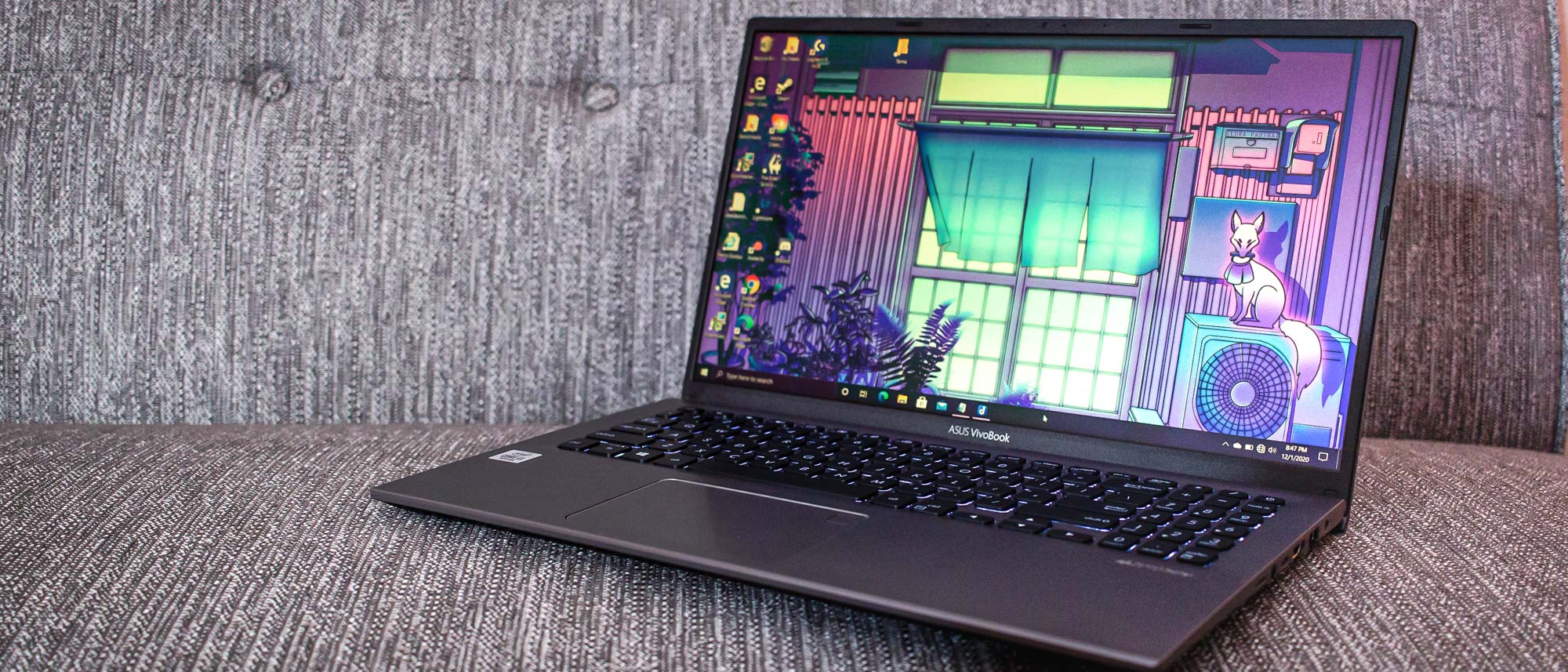Tom's Guide Verdict
The Asus VivoBook 15 is capable of common tasks and a bit of video game nostalgia, but it's not the upgrade you're looking for.
Pros
- +
Affordable
- +
Full keyboard layout
- +
Extremely light
- +
Ample port selection
Cons
- -
Poor battery life
- -
Dull display
- -
Muffled sound
Why you can trust Tom's Guide
Price: $399
CPU: Intel Core i3-1005G1
GPU: Intel UHD
RAM: 8GB
Storage: 128GB SSD
Display: 15.6-inch, 1920 x 1080
Battery: 5:20
Size: 14.1 x 9.2 x 0.8 inches
Weight: 3.7 pounds
The Asus VivoBook 15 is a budget laptop we had high hopes for. Budget laptops, as you might well know, often seem like they're too good to be true. The idea that you can get enough performance to carry you through a few years at an exceptionally reasonable price is quite enticing. But often, when you're paying less, you're getting less, too.
In the case of the latest refresh of the Asus VivoBook 15, you're paying for less performance and less battery life and opting for a less vibrant display. In exchange, you get numerous ports, a thin chassis, and a nearly edge-to-edge widescreen display, but this Asus VivoBook 15 review will show how the result is merely a reminder of the compromises one has to make to save money.
Asus VivoBook 15 review: Price and Configurations
The $400 Asus VivoBook 15 featured here is an Intel Core i3-1005G1 model with 8GB of RAM and 128GB SSD storage. If you can spring an extra $200, you might consider another variant of the VivoBook 15 with an Intel i5-1035G1 processor and a 512GB SSD. There's also an AMD option with a Ryzen 7 3700U processor and 512GB of storage for $650.
Asus VivoBook 15 review: Design
The Asus VivoBook 15 excels at dressing for the job it wants. Its slate-gray chassis doesn't look like a budget laptop, and despite its plastic build and relative lightness — a mere 3.7-pounds, lighter than the Acer Aspire 5 and HP 15 (3.8 pounds and 4.4 pounds, respectively) — it all feels cohesive in its overall design and construction.
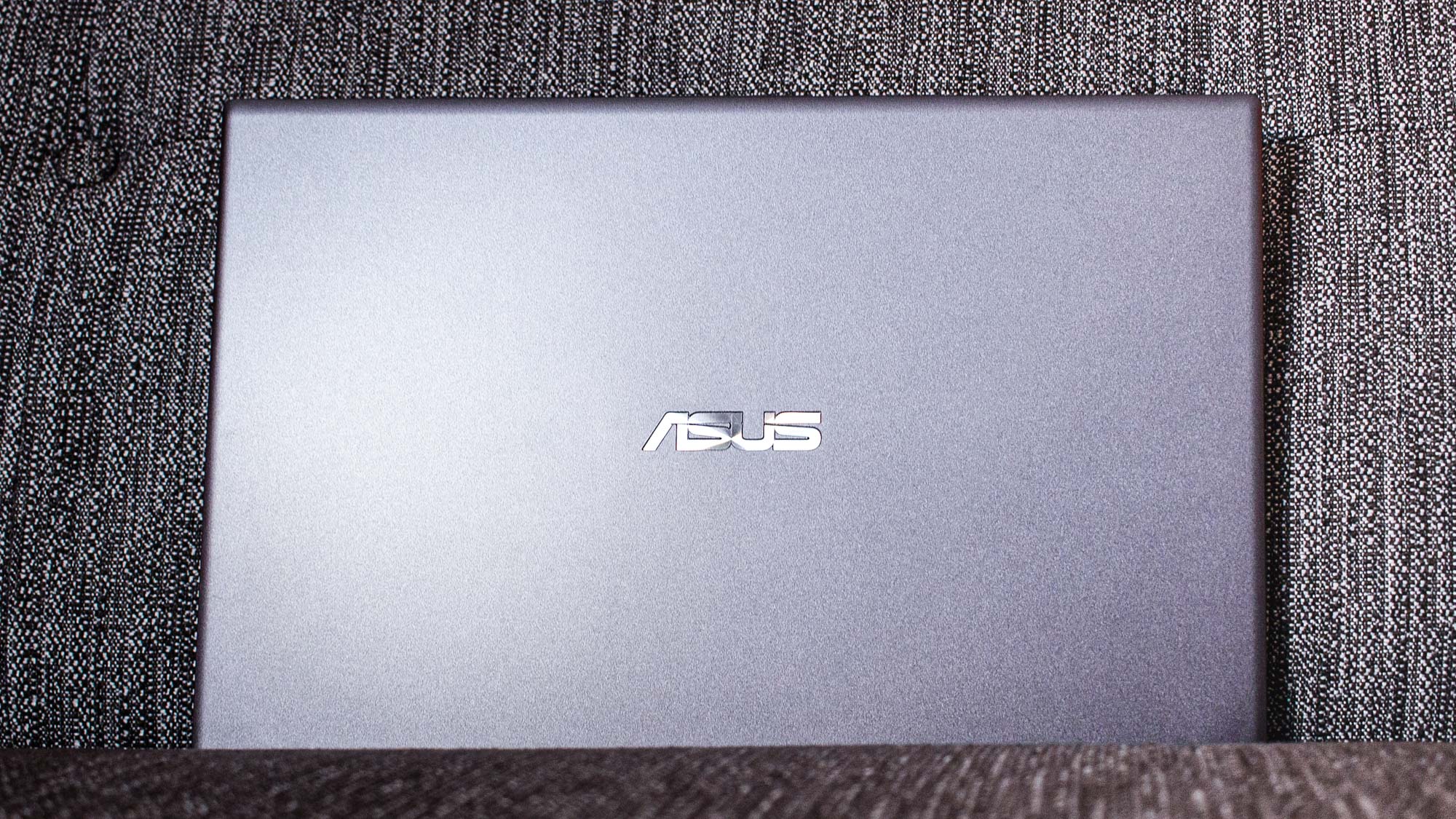
The inside of the VivoBook 15 reveals a keyboard fitted to the rest of the laptop like on Asus' premium models. The trackpad is flush on the wrist rest without being too obvious, and there's even a fingerprint scanner for locking up your system.
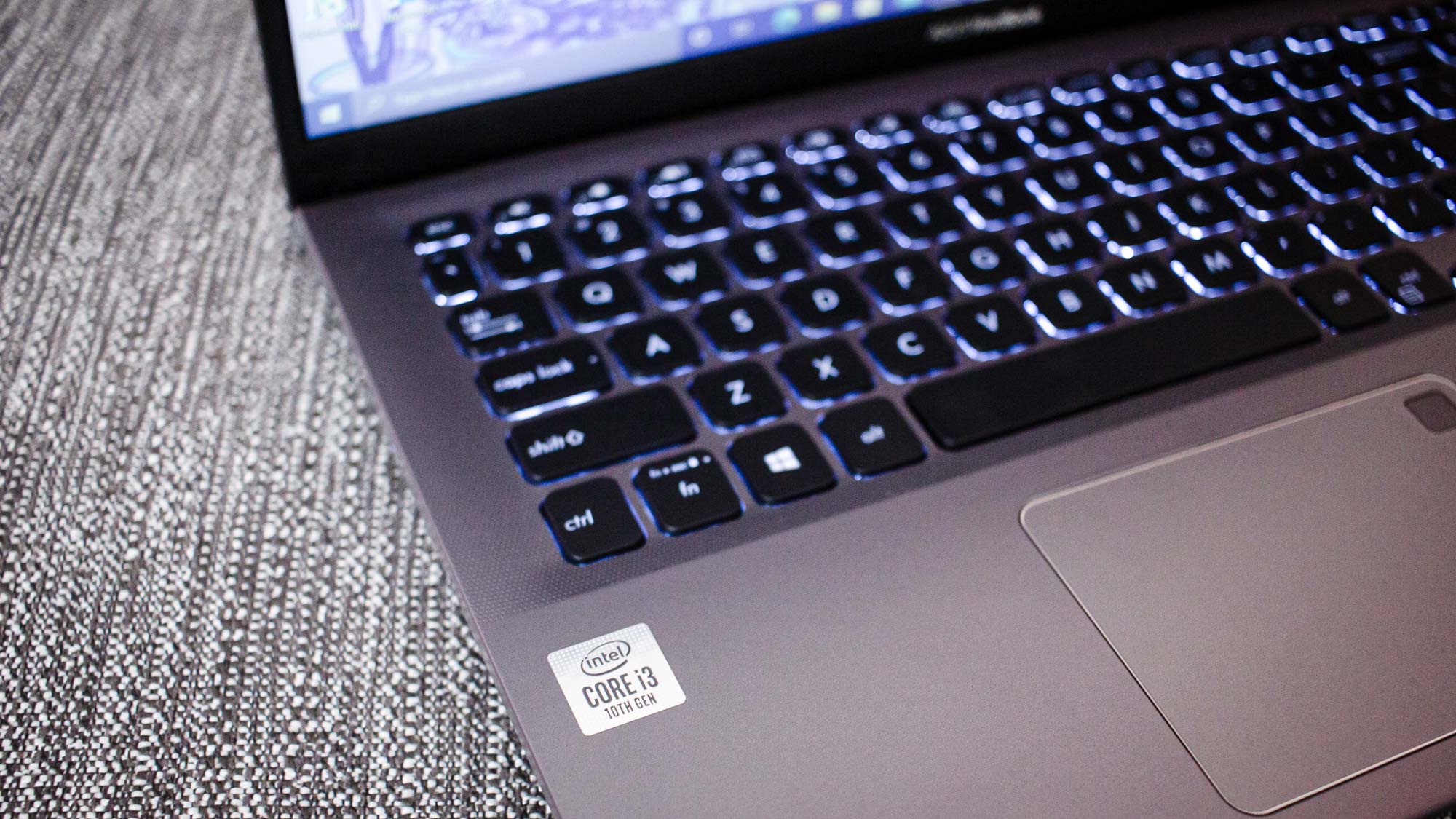
Asus managed to fit in a whole number pad without crowding the keyboard area, and there's enough room for comfortably resting your wrist while thumbing through your work.
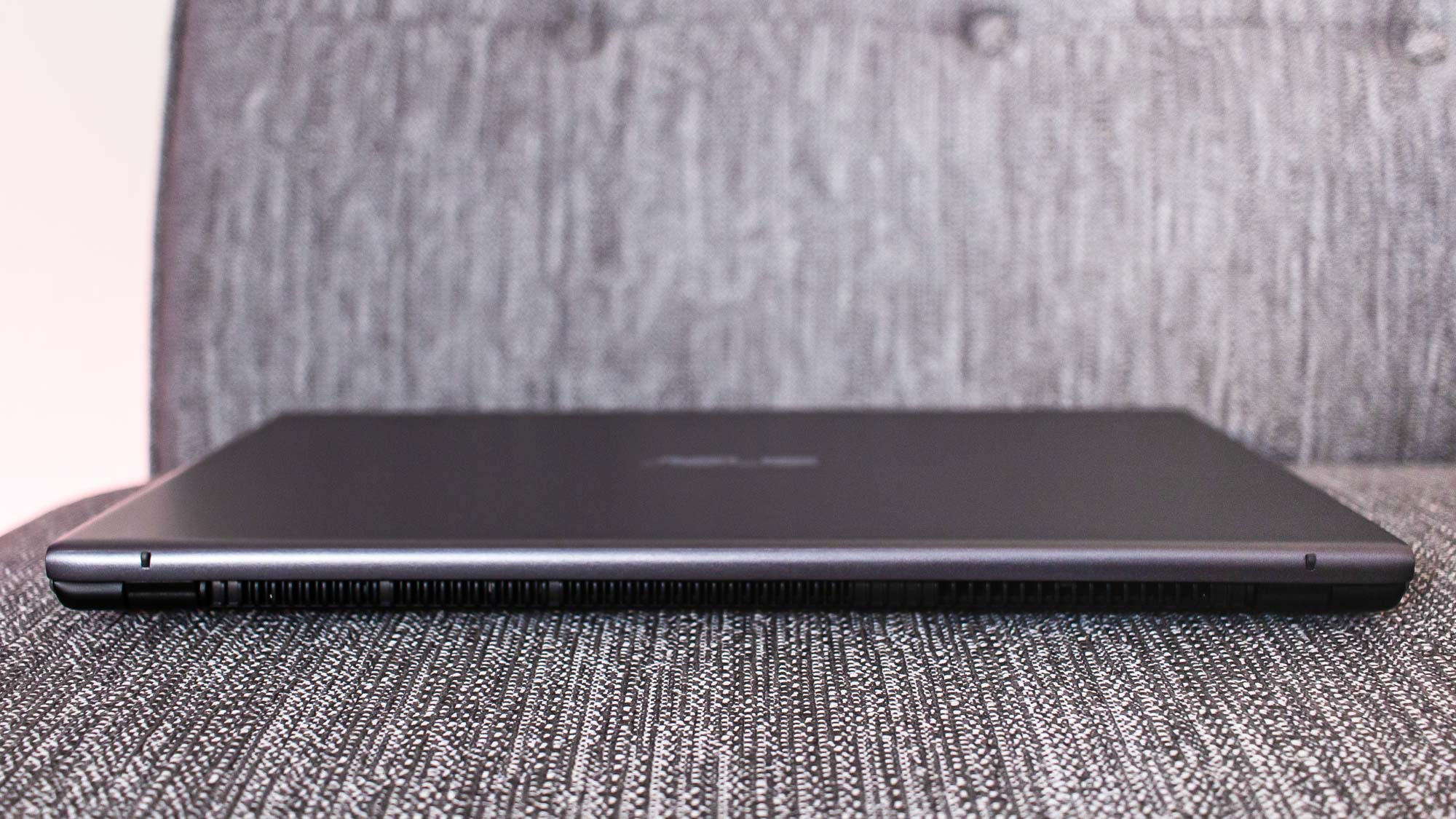
The VivoBook 15's ErgoLift Hinge is one of its more helpful facets, as it angles the keyboard so that it's raised a bit for more comfortable typing when you're seated at a desk. It's a feature carried over from some of Asus' ROG gaming laptops (some of the best gaming laptops you can buy) for increasing ergonomics on the go. It's nice that the company implemented it into its lower-tier laptops.
Asus VivoBook 15 review: Ports
Buying a laptop with plenty of ports is a good idea if you're ever considering docking the device and working with a full set up. The laptop's left side has two traditional USB 2.0 Type-A ports, plus a status indicator light.
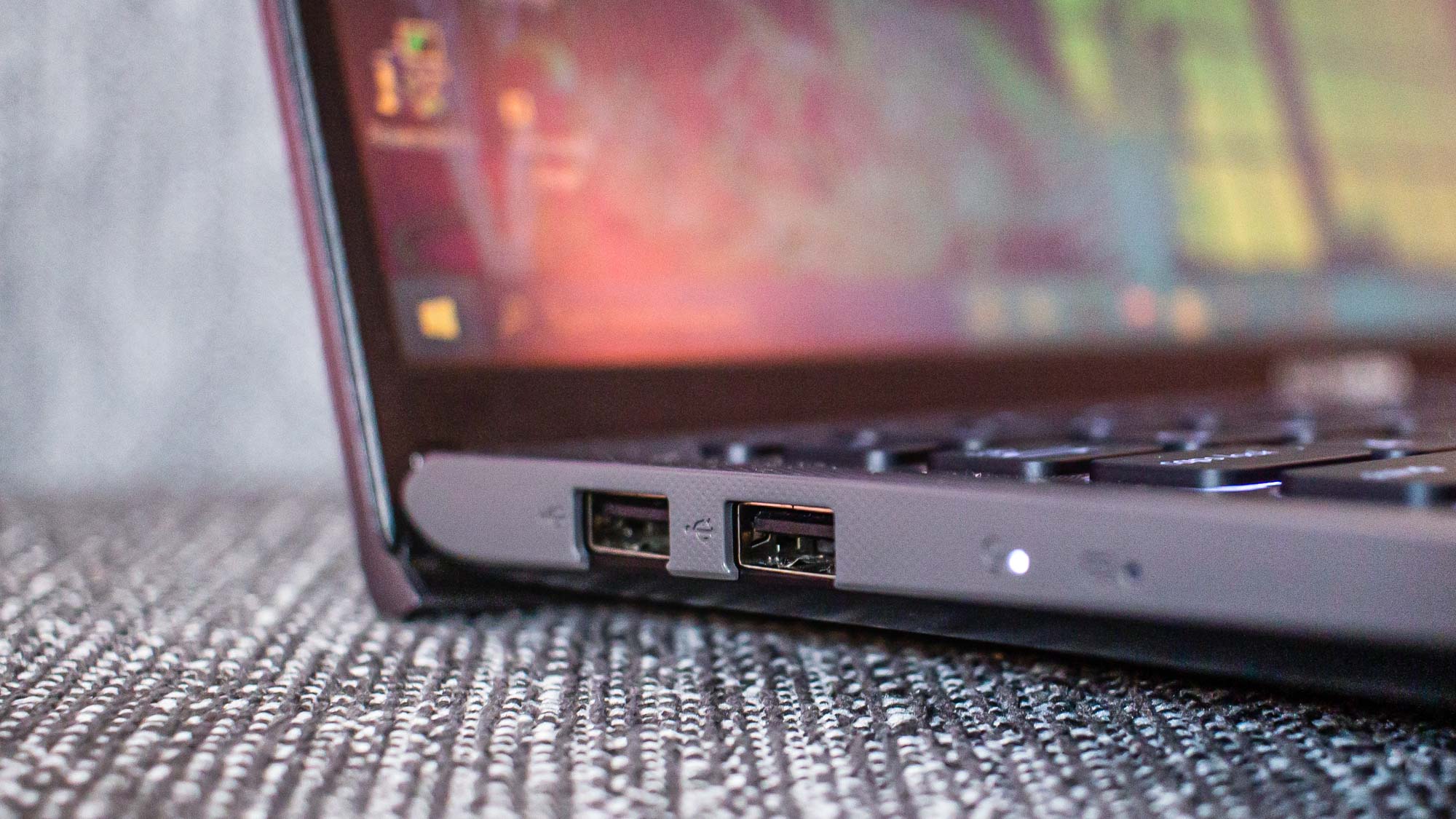
The right side has the rest of the bounty, housing a proprietary power jack, a USB 3.1 Type-A port, an HDMI 2.0 port for tethering the laptop, and a combination headphone and microphone jack. There's a USB Type-C port, a rarity for a laptop in this price range, and a way for you to add an Ethernet port by way of a compatible adapter.
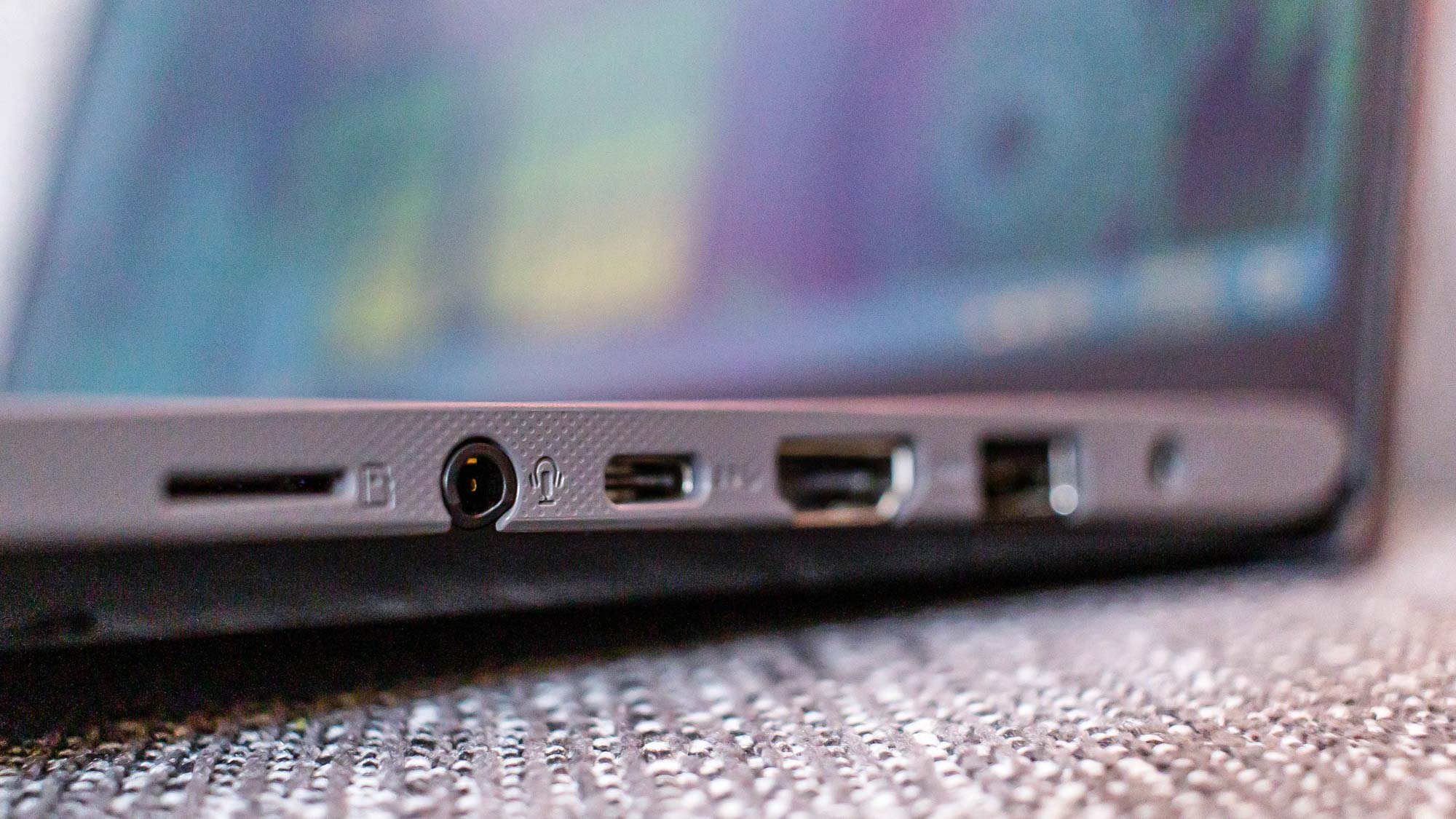
There's also a MicroSD slot, which is a nice-to-have and allows adding on storage space, but I would have preferred a standard SD slot to work with my DSLR on the go.
Asus VivoBook 15 review: Display
The VivoBook 15's 15.6-inch, 1920 x 1080 NanoEdge display offers little bezel on either side of the laptop, with a bit more at the top to accommodate the webcam. But beyond its widescreen look, the display's dim color profile and weird viewing angles make it an underwhelming device for consuming online video. It made episodes of vintage TV shows like Baywatch, already with a worn-in color palette, look older than they are, while movies like the recent remake of Emma were extremely hard to see in dark scenes.
In lab tests, the VivoBook 15 scored a measly 65 percent on the sRGB color gamut. While that's ahead of similarly-priced laptops, including the Acer Aspire 5, which scored 63 percent, and the HP 15, which scored 67 percent, it's behind the industry average of 85 percent. Anecdotally, the display on the VivoBook 15 is obviously off-kilter. I can get through a YouTube video without immediately recognizing it, but it becomes apparent once I switch displays. And while I was able to edit RAW photos in Adobe Lightroom, I felt more confident about the result only after connecting to an external monitor with better color reproduction.
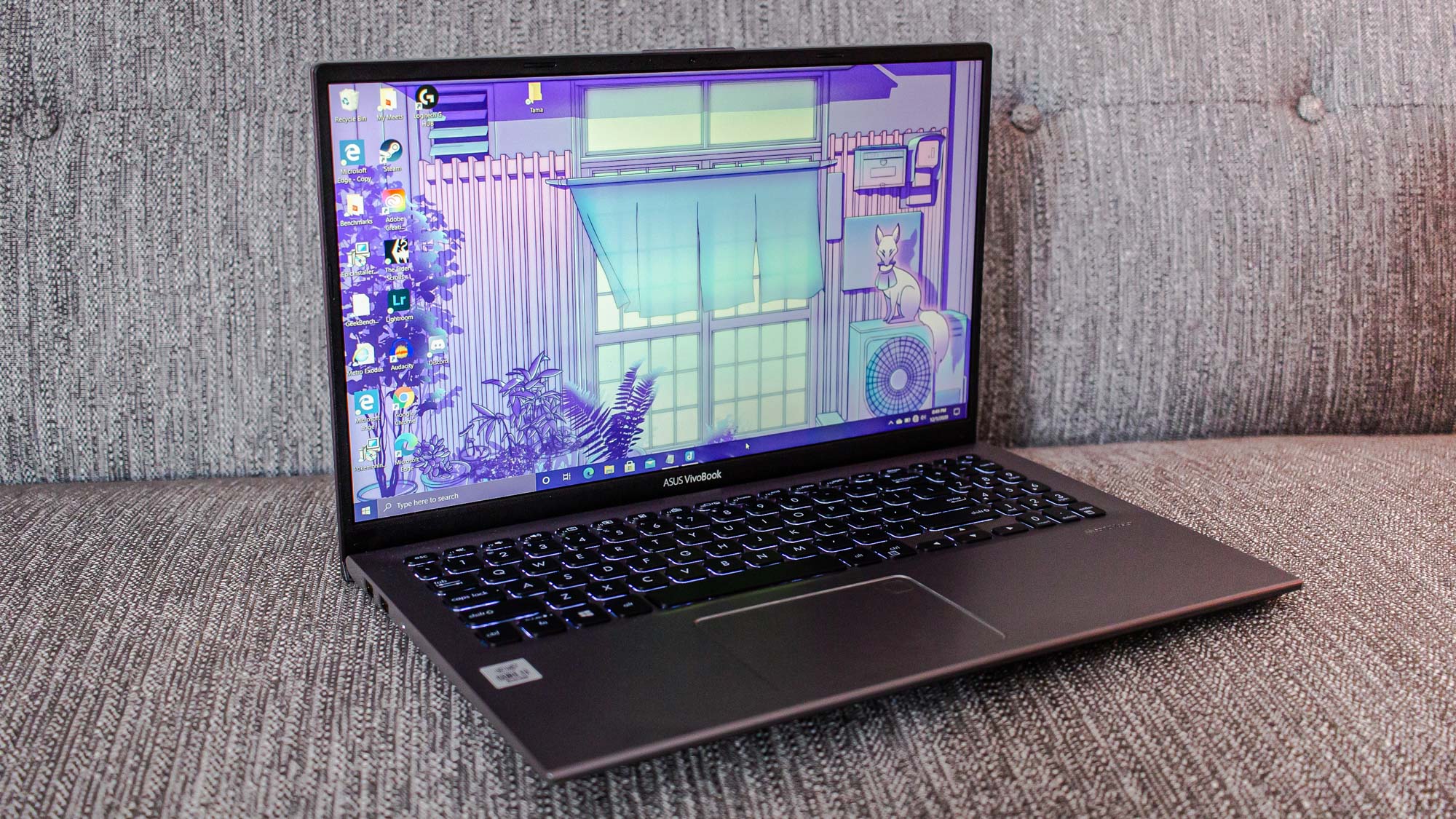
The viewing angles of the VivoBook 15 are a bit odd, too. You have to look at the laptop at an exact angle — about 100 degrees — to see the display without a sheen. The issue affects dark colors, specifically black and grays, and if you rely on dark mode within most apps, it's hard to ignore. I found the laptop hard to use with the Windows 10 night mode because of this sheen issue. It's also not very bright, with the VivoBook 15 maxing out at 205 nits in lab tests. The Acer Aspire 5 and HP 15 Laptop are brighter, measuring at 258 nits and 222 nits, respectively, though even those models are below the industry average of 268 nits. Whichever way you shake it, the VivoBook 15 isn't meant for a cinematic viewing experience.
Asus VivoBook 15 review: Audio and Cameras
The bottom-facing dual speakers on the Asus VivoBook 15 need a little boost. You can listen to music and watch a movie without headphones, but the sound will seem as if it's strained. The Midnight’s Deep Blue’s strong melody, for example, came through clearly enough, while the vocals seemed as if they were coming in from a distance. Bassier genres of music, like house and synthwave, sound just as hollow, and sometimes it's hard to hear vocals even on podcasts. While I was watching Emma, I could barely hear the dialogue with the laptop set down on a table. You're better off pairing the laptop with external speakers to listen to anything.
The 720p built-in webcam exists as a failsafe for when you're called into an unexpected video conference. But you'll want an external webcam to pair with the VivoBook 15, as the quality on the included one is comparable to a webcam I had over ten years ago. It's too bad the camera is an after-thought even on budget laptops because there are so many students and professionals who could benefit from the presence of higher quality video.
Asus VivoBook 15 review: Keyboard and Touchpad
The keyboard on the VivoBook 15 is a bit polarizing. The chiclet keys are comfortable to type on, and there is ample backlighting to get work done with the lights down low. I appreciate the number pad squeezed into the right side of the keyboard and that it can be easily turned on and off with a Number Lock key, like a full-sized external keyboard.
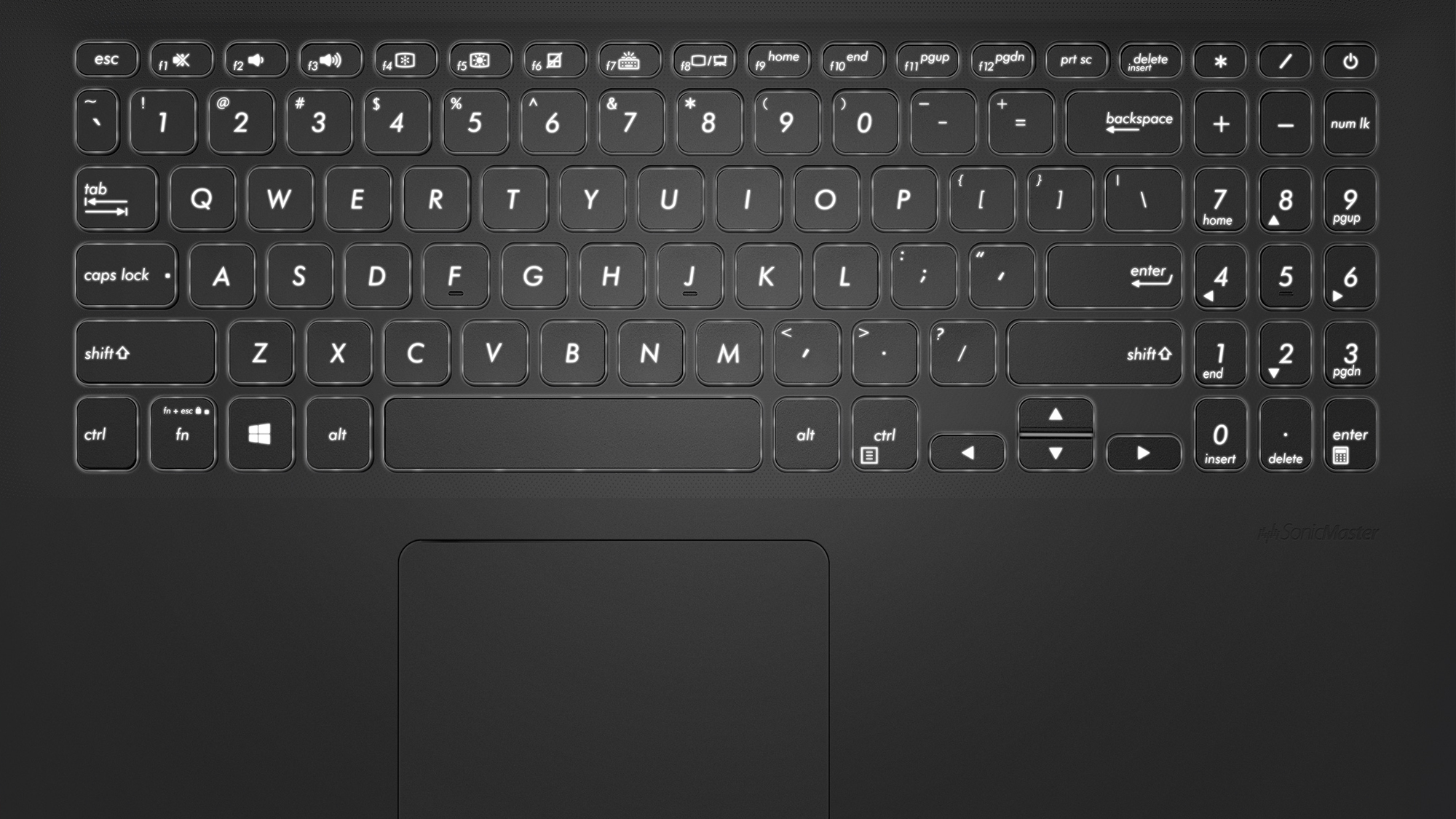
But after about an hour of working with the keyboard, I found myself frustrated by the distance between the keys. They're so widely spaced that it feels like trudging through the Sahara. I lost myself in the configuration any time the backlight went out. I also found the placement of a few keys, Page Up and Page Down, farther apart than where I naturally wanted to rest my fingers. Plan to work with this laptop docked if you want to get things done.
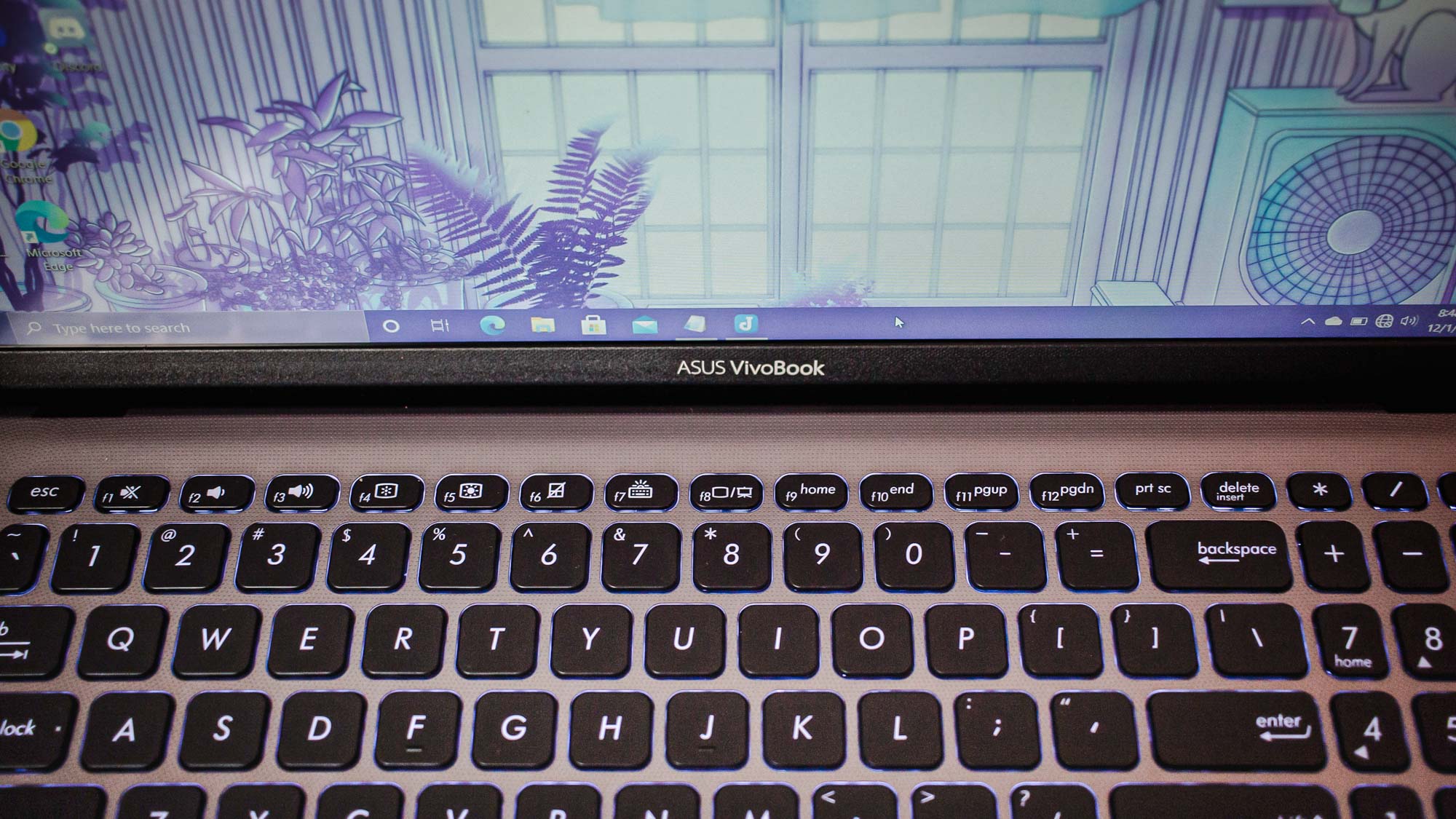
Trying to use Windows 10 gestures on the VivoBook 15's 4.1 x 2.9-inch trackpad proved annoying at times. I found myself with lots of unwanted swipes, so I just turned them off. The trackpad could be a bit bigger, as it feels off-center at its current placement and width.
Asus VivoBook 15 review: Performance
The VivoBook's Intel Core-i3 processor and 8GB of RAM are quite able, despite their mediocre benchmarks. I was able to sift through dozens of Google Chrome tabs, plus shuffle through my cloud-based library in Adobe Lightroom without the fans sounding like they were readying for takeoff. I gave the integrated Intel UHD graphics a spin to see if it could run an old favorite. I loaded up Elder Scrolls V: Skyrim and the VivoBook 15 maintained between 18 and 25 frames-per-second as I walked through low-quality-rendered snowy mountains.
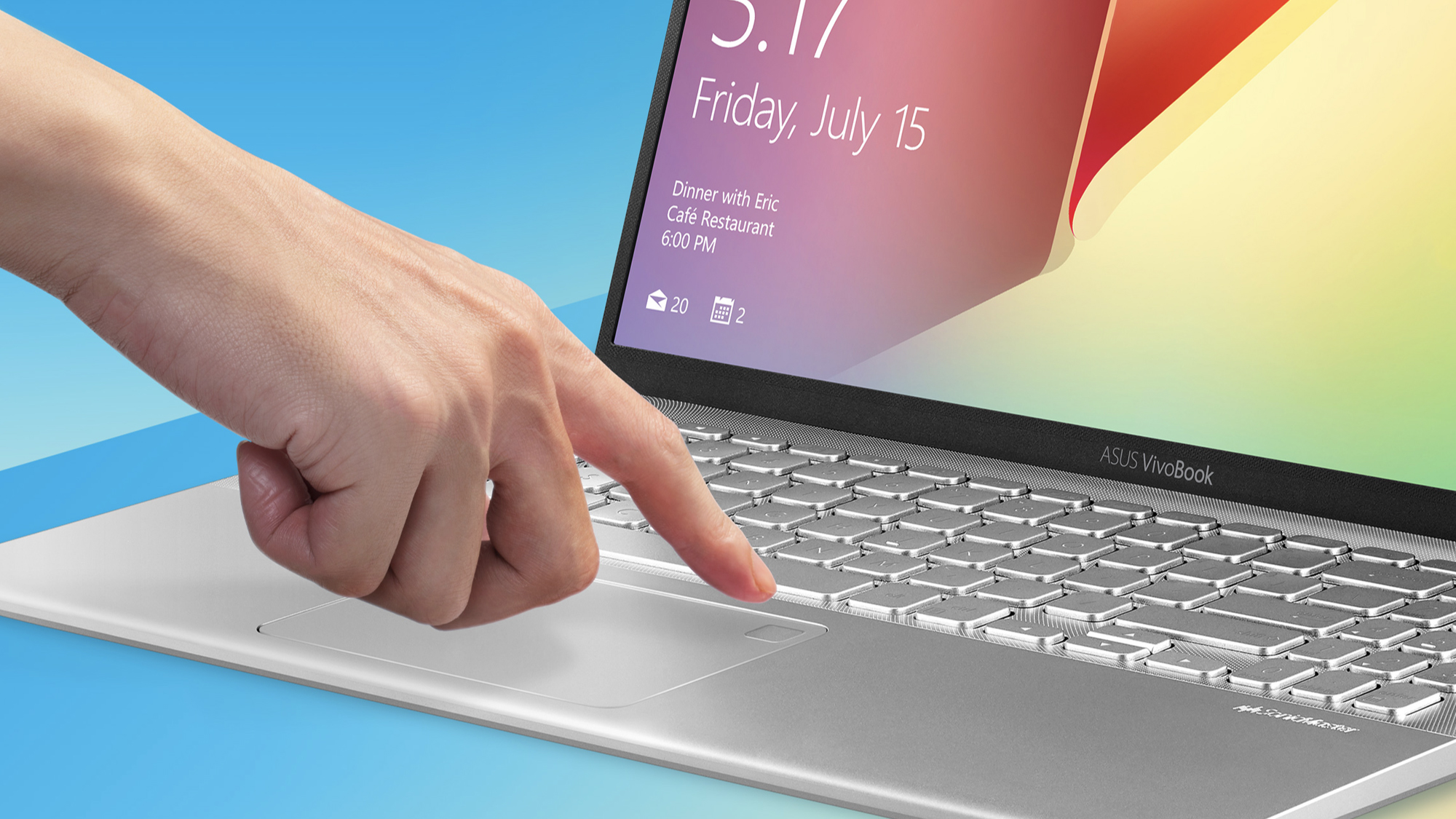
It seems like you can do plenty with the VivoBook 15, but most budget laptops feel this way at first. The VivoBook 15's benchmark numbers show how little the laptop has to start with. It scored 2,399 overall on Geekbench 5, a testing suite that measures everyday computer tasks like browsing the internet and rendering augmented reality effects. That's below the Acer Aspire 5, which scored 2,744, and even further down the graph from the industry average of 2,983.
Our Handbrake video transcoding tests gave the VivoBook 15 another chance to get outperformed. The VivoBook 15 managed to transcode 4K video to 1080p resolution within 28 minutes and 33 seconds. The Acer Aspire 5 and HP 15 were much faster, transcoding at 21:55 and 25:53, respectively. The VivoBook 15 was faster than the 40 minute average for other budget laptops that took this test.
Asus VivoBook 15 review: Battery Life
Most budget laptops can last well over six hours on one charge of the battery, but the VivoBook 15 struggled to hit this mark. It lasted only five hours and 20 minutes through continuous web surfing over Wi-Fi at 150 nits of brightness. Although this beat out the Acer Aspire 5 (6:55) and the HP 15 Laptop (4:57) in lab tests, it's at the tail end of the spectrum compared to the average of other budget laptops tested (6:39).
I used the VivoBook 15 with low brightness and the least aggressive setting in Windows 10's battery-saving mode and noticed only slightly better numbers than the lab tests. The VivoBook 15 burned through 15 percent of battery after about an hour into a work session. Two hours later, the laptop used up 45 percent at the same setting. That's nearly 50 percent after three hours of use. Perhaps I could have eked out a bit more time by futzing with the power saving settings. It's clear from the numbers that the VivoBook 15 can barely manage six hours of continuous use.
Asus VivoBook 15 review: Heat
The VivoBook 15 is consistent and capable at distributing heat, and it felt temperate enough to use on my lap. In lab tests, the VivoBook 15's keyboard measured about 72 degrees Fahrenheit throughout, while the underside measured higher at 91 degrees. Overall, the laptop never felt too hot to use.
I didn't find the fans in the Asus VivoBook 15 to be as loud as other laptops we've tested, namely the Acer Aspire 5.
Asus VivoBook 15 Verdict
Theoretically, if I were in a rush and needed a so-called throwaway laptop to perform a few quick deeds, the Asus VivoBook 15 would be likely to carry me through. It has enough power to run an older game at low-quality settings to help fulfill the nostalgia quotient. It has enough battery life to file words at a Denny's in time for the next deadline. But as this Asus VivoBook 15 review showed, performance doesn't particularly impress, which doesn't make it a laptop worth an upgrade.
At least there are plenty of ports, so if the VivoBook 15 is the only choice you have in your arsenal, an external monitor, a set of speakers, and a mouse can help with some of its quirks. But if you can swing it, at least consider spending a few hundred more on the Core-i5 version of the VivoBook 15 for a little more power in the processor.

Alex Wawro is a lifelong tech and games enthusiast with more than a decade of experience covering both for outlets like Game Developer, Black Hat, and PC World magazine. A lifelong PC builder, he currently serves as a senior editor at Tom's Guide covering all things computing, from laptops and desktops to keyboards and mice.
